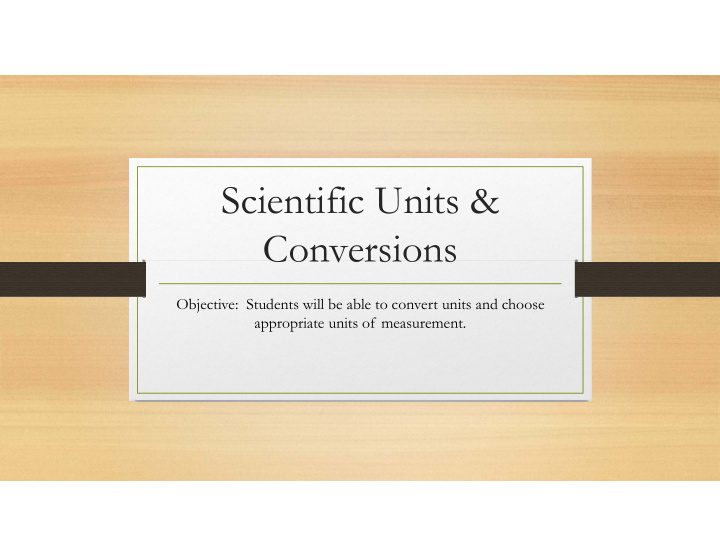



Scientific Units & Conversions Objective: Students will be able to convert units and choose appropriate units of measurement.
Students will be able to convert units and chose appropriate units of measurement. Basic S.I. Units • S.I. Units: Units of measurement that all scientist across the world agree to use. • Normally they use the metric system, but there are some exceptions (i.e. Temperature is Celsius in the metric system but is Kelvin in S.I. units. I will be able to use dimensional analysis to convert a metric unit.
Students will be able to convert units and chose appropriate units of measurement. Basic S.I. Units • Important Metric Prefixes Measurement Unit Abbreviation of Unit Length Mass Time Weight / Force Speed I will be able to use dimensional analysis to convert a metric unit.
Students will be able to convert units and chose appropriate units of measurement. Metric Prefixes • Important Metric Prefixes Prefix Conversion Rate Prefix Abbreviation. Kilo- = 1 Base Unit (like a meter) Centi- = 1 Base Unit Milli- = 1 Base Unit I will be able to use dimensional analysis to convert a metric unit.
Students will be able to convert units and chose appropriate units of measurement. Dimensional Analysis • Dimensional Analysis: A way to convert units by using fractions that represent the conversion ratios. • Steps for Dimensional Analsys: 1. Write the original Value as a Fraction 2. Create a new fraction beside the original, place the units on the new fraction to cancel out the original unit. 3. Place the conversion numbers beside the matching unit. 4. Repeat steps 2 and 3 until you have converted to the appropriate unit. I will be able to use dimensional analysis to convert a metric unit.
Students will be able to convert units and chose appropriate units of measurement. Dimensional Analysis Practice • Sometimes you may have to convert more than one unit at a time. Still follow the same steps. • Example: Turning Km/H to m/s. I will be able to use dimensional analysis to convert a metric unit.
Students will be able to convert units and chose appropriate units of measurement. Dimensional Analysis Example 1: Convert 86.5 grams to kilograms. I will be able to use dimensional analysis to convert a metric unit.
Students will be able to convert units and chose appropriate units of measurement. Dimensional Analysis Example 2: Convert 9.8 cm to m. I will be able to use dimensional analysis to convert a metric unit.
Students will be able to convert units and chose appropriate units of measurement. Dimensional Analysis Example 3: Convert 45 km/h to m/s I will be able to use dimensional analysis to convert a metric unit.
Students will be able to convert units and chose appropriate units of measurement. Dimensional Analysis Example 4: Convert 1,000,000 seconds into a years. I will be able to use dimensional analysis to convert a metric unit.
Students will be able to convert units and chose appropriate units of measurement. Scientific Notation • Scientific Notation: A way to write a number using powers of ten. Steps to Writing Scientific Notation. 1. Create the digit by moving the decimal to create a number that is BEWTEEN 1 and 10. 2. Multiply by 10. 3. Count the number of places the decimal has moved, a create the exponent for 10. 4. Moved Left = Positive, Moved Right = Negative. I will be able to use dimensional analysis to convert a metric unit.
Students will be able to convert units and chose appropriate units of measurement. Scientific Notation Changing Sci. Not. back to Standard Notation 1. If the exponent is “+”, move the decimal right (make the number bigger), if “ - ” move the decimal left. I will be able to use dimensional analysis to convert a metric unit.
Scientific Notation with a Calculator • Example: 2.99 x 10 8 will look like ( 2.99 E 8 ) on the calculator. • Type: ( 2.99 ) ( 2 nd ) (x -1 ) ( 8 )
Students will be able to convert units and chose appropriate units of measurement. Scientific Notation Examples • Example 1: Write the mass of the Earth in Scientific Notation. 5,973,600,000,000,000,000,000,000 kg I will be able to use dimensional analysis to convert a metric unit.
Students will be able to convert units and chose appropriate units of measurement. Scientific Notation Examples • Example 2: Write the diameter of a carbon-12 atom in scientific notation. • 0.0000000000000000000000299 mm • I will be able to use dimensional analysis to convert a metric unit.
Students will be able to convert units and chose appropriate units of measurement. Scientific Notation Examples • Example 3: The mass of a proton is only 1.66 × 10 -27 kg. Write this number in standard form. I will be able to use dimensional analysis to convert a metric unit.
Students will be able to convert units and chose appropriate units of measurement. Scientific Notation Examples • Example 4: • The distance from the Earth to the Sun is 1.49 x 10 11 meters. Using dimensional analysis, convert this value to kilometers and write it in Standard Notation. I will be able to use dimensional analysis to convert a metric unit.
Students will be able to convert units and chose appropriate units of measurement. Identifying Parts of an Experiment • AVID Experiment Vocabulary Note Sheet. • Guide to Creating an Experiment Note sheet. I will be able to use dimensional analysis to convert a metric unit.
Recommend
More recommend